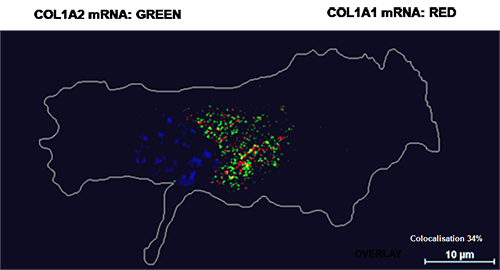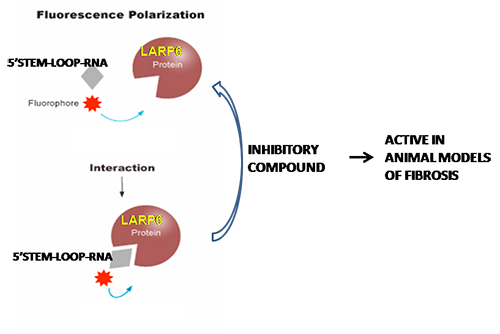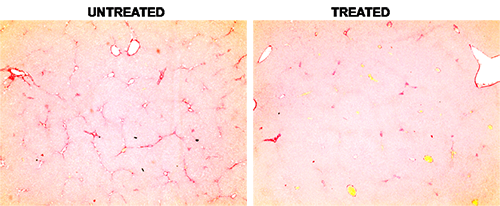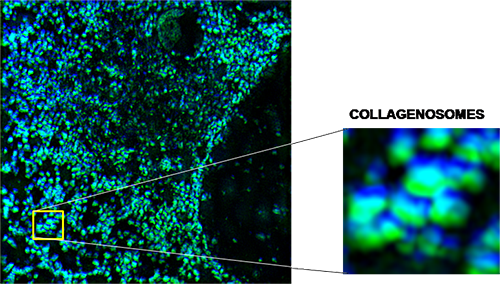Stefanovic Lab
The Stefanovic lab studies molecular mechanisms of type I collagen expression in fibrosis and develops high throughput screening methods to find out specific antifibrotic drugs.
These efforts have discovered that production of type I collagen in fibrosis is regulated differently than the constitutive type I collage synthesis. The mechanism active in fibrosis requires binding of protein LARP6 to the unique sequence found only in type I collagen mRNAs, the 5’ stem-loop. The binding of LARP6 to the 5’ stem-loop of two mRNAs encoding type I collagen polypeptides co-localizes the mRNAs on the membrane of the endoplasmic reticulum and increases the production and folding of the polypeptides. Below is shown the co-localization of two mRNAs encoding type I collagen polypeptides in a cell responsible for pulmonary fibrosis.

The specificity of LARP6 dependent regulation to type I collagen and its importance for fibrosis development has been verified by in vitro experiments and by an animal model and is the basis for our efforts to discover specific antifibrotic drugs. Our premise is that the inhibitors of LARP6 binding to collagen mRNAs can be a novel class of antifibrotic drugs. To enable screening for such inhibitors we have develop several high throughput screening methods, including a target based method and two phenotypic methods.
The target based method uses fluorescence polarization and has already been employed to screen a chemical library for inhibitors of LARP6 binding. A compound has been discovered that can dissociate LARP6 from the 5’ stem-loop of collagen mRNAs and this compound proved to have a potent antifibrotic activity in animal models of hepatic fibrosis.

When our LARP6 inhibitor was tested in several models of hepatic fibrosis in rats it prevented development of fibrosis or attenuated the progression of already existing fibrosis when administered at 1 mg/kg. The histology of liver fibrosis found in an untreated animal and in an animal treated with our inhibitor is shown below.

We are currently developing phenotypic methods for screening of LARP6 inhibitors. One of these methods utilizes our proprietary collagen biosensor technology. The collagen biosensor technology allows visualization of collagen polypeptides and their folding into type I collagen in live cells. By imaging the biosensor, it became evident that type I collagen is not synthesized uniformly throughout the endoplasmic reticulum, but that it is formed in discrete bodies. We estimated that there are about 2000 of these bodies per cell, which we termed collagenosomes. Formation of collagenosomes is LARP6 dependent and is a result of clustering of collagen mRNAs. Below is an image of collagenosomes found in a cell responsible for hepatic fibrosis.

The phenotypic screen for LARP6 inhibitors currently in final stages of development is based on imaging the change in formation and morphology of the collagenosomes. This readout will allow detection of compounds which interfere with the process of type I collagen formation, including but not limited, to LARP6 inhibitors.

